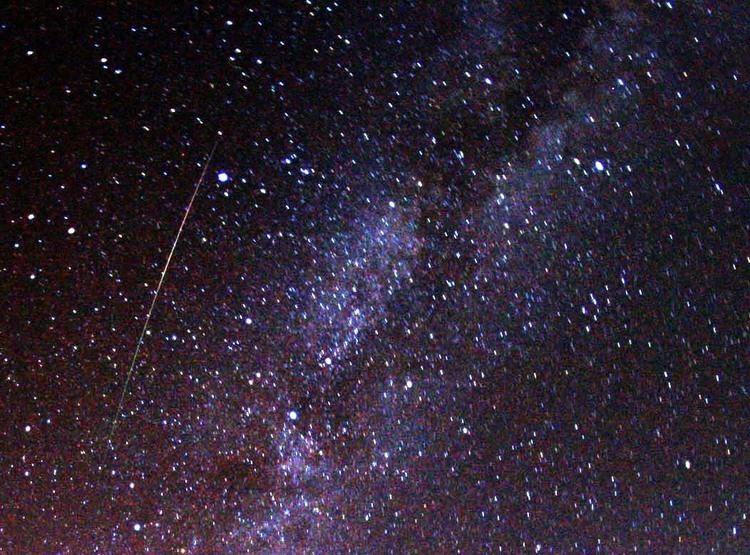Pronunciation /ˈpərsiːɪdz/ Right ascension 03 04 | Discovery date 36 CE (first record) Declination +58° | |
 | ||
The Perseids /ˈpərsiːɪdz/ are a prolific meteor shower associated with the comet Swift–Tuttle. The Perseids are so called because the point from which they appear to come, called the radiant, lies in the constellation Perseus. The name derives in part from the word Perseides (Περσείδες), a term found in Greek mythology referring to the sons of Perseus.
Contents
Etymology
The stream of debris is called the Perseid cloud and stretches along the orbit of the comet Swift–Tuttle. The cloud consists of particles ejected by the comet as it travels on its 133-year orbit. Most of the particles have been part of the cloud for around a thousand years. However, there is also a relatively young filament of dust in the stream that was pulled off the comet in 1865, which can give an early mini-peak the day before the maximum shower. The dimensions of the cloud in the vicinity of the Earth are estimated to be approximately 0.1 astronomical units (AU) across and 0.8 AU along the latter’s orbit, spread out by annual interactions with the Earth’s gravity.
The shower is visible from mid-July each year, with the peak in activity between 9 and 14 August, depending on the particular location of the stream. During the peak, the rate of meteors reaches 60 or more per hour. They can be seen all across the sky; however, because of the shower’s radiant in the constellation of Perseus, the Perseids are primarily visible in the Northern Hemisphere. As with many meteor showers the visible rate is greatest in the pre-dawn hours, since more meteoroids are scooped up by the side of the Earth moving forward into the stream, corresponding to local times between midnight and noon, as can be seen in the accompanying diagram. While many meteors arrive between dawn and noon, they are usually not visible due to daylight. Some can also be seen before midnight, often grazing the Earth’s atmosphere to produce long bright trails and sometimes fireballs. Most Perseids burn up in the atmosphere while at heights above 80 kilometres (50 mi).
Historical observations and associations
Some Catholics refer to the Perseids as the "tears of Saint Lawrence", suspended in the sky but returning to earth once a year on August 10, the canonical date of that saint's martyrdom in 258 AD. The saint is said to have been burnt alive on a gridiron, and this tradition is almost certainly the origin of the Mediterranean folk legend that the shooting stars are the sparks of that fire and that during the night of August 9–10 its cooled embers appear in the ground under plants, and which are known as the "coal of Saint Lawrence". The transition in favor of the Catholic saint and his feast day on August 10 and away from pagan gods and their festivals, known as Christianization, was facilitated by the phonetic assonance of the Latin name Laurentius with Larentia.
In 1835, Adolphe Quetelet identified the shower as emanating from the constellation Perseus. In 1866, after the perihelion passage of Swift-Tuttle in 1862, the Italian astronomer Giovanni Virginio Schiaparelli discovered the link between meteor showers and comets. The finding is contained in an exchange of letters with Angelo Secchi.
In popular culture
In his song "Rocky Mountain High", American singer-songwriter John Denver refers to his experience watching the Perseid meteor shower during a family camping trip in the mountains near Aspen, Colorado, with the chorus lyric, "I've seen it raining fire in the sky."
In the popular Japanese band Sandaime J Soul Brothers's song "R.Y.U.S.E.I" (Meteor), they describe the Perseid meteor as falling like an evening rain shower – its shooting stars like raindrops pulling their tails behind them.
